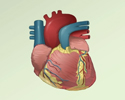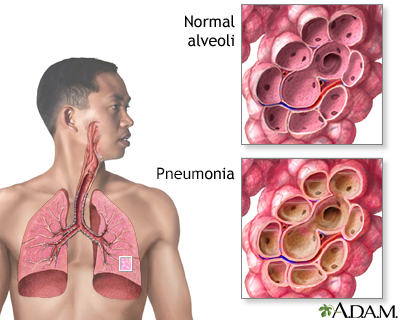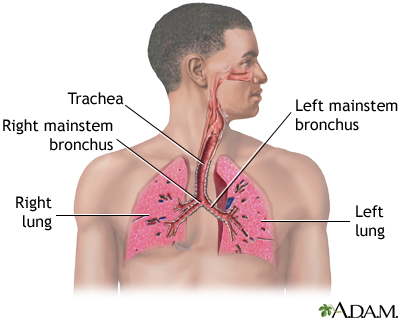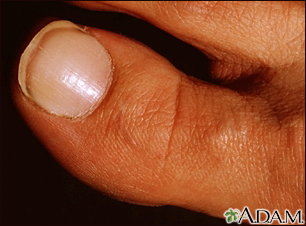Community-acquired pneumonia in adults
Bronchopneumonia; Community-acquired pneumonia; CAPPneumonia is inflamed or swollen lung tissue due to infection with a germ.
This article covers community-acquired pneumonia (CAP). This type of pneumonia is found in people who have not recently been in the hospital or another health care facility such as a nursing home or rehab facility. Pneumonia that affects people in or recently released from a health care facility, such as hospitals, is called hospital-acquired pneumonia (or health care-associated pneumonia).
Hospital-acquired pneumonia
Hospital-acquired pneumonia is an infection of the lungs that occurs during a hospital stay. This type of pneumonia can be very severe. Sometimes, ...

Causes
Pneumonia is a common illness that affects millions of people each year in the United States. Germs called bacteria, viruses, and fungi may cause pneumonia. In adults, bacteria are the most common cause of pneumonia.
Ways you can get pneumonia include:
- Bacteria and viruses living in your nose, sinuses, or mouth may spread to your lungs.
- You may breathe some of these germs directly into your lungs.
- You breathe in (inhale) food, liquids, vomit, or fluids from the mouth into your lungs (aspiration pneumonia).
Aspiration pneumonia
Pneumonia is inflammation (swelling) and infection of the lungs or large airways. Aspiration pneumonia occurs when food or liquid is breathed into th...
 ImageRead Article Now Book Mark Article
ImageRead Article Now Book Mark Article
Pneumonia can be caused by many types of germs.
- The most common type of bacteria is Streptococcus pneumoniae (pneumococcus).
- Atypical pneumonia, often called walking pneumonia, is caused by other bacteria.
Atypical pneumonia
Pneumonia is inflamed or swollen lung tissue due to infection with a germ. With atypical pneumonia, the infection is caused by different bacteria tha...
 ImageRead Article Now Book Mark Article
ImageRead Article Now Book Mark Article - A fungus called Pneumocystis jirovecii can cause pneumonia in people whose immune system is not working well, especially people with advanced HIV infection.
- Viruses, such as the flu (influenza) virus, and most recently SARS-CoV-2 (which causes COVID-19), are also common causes of pneumonia.
Viruses
Pneumonia is inflamed or swollen lung tissue due to infection with a germ. Viral pneumonia is caused by a virus.
 ImageRead Article Now Book Mark Article
ImageRead Article Now Book Mark ArticleCOVID-19
Coronavirus disease 2019 (COVID-19) is a respiratory illness that causes fever, coughing, and shortness of breath, but many other symptoms can occur....
 ImageRead Article Now Book Mark Article
ImageRead Article Now Book Mark Article
Risk factors that increase your chance of getting pneumonia include:
- Chronic lung disease (COPD, bronchiectasis, cystic fibrosis)
COPD
Chronic obstructive pulmonary disease (COPD) is a common lung disease. Having COPD makes it hard to breathe. There are two main forms of COPD:Chroni...
 ImageRead Article Now Book Mark Article
ImageRead Article Now Book Mark ArticleBronchiectasis
Bronchiectasis is a disease in which the large airways in the lungs are damaged. This causes the airways to become permanently wider. Bronchiectasis...
 ImageRead Article Now Book Mark Article
ImageRead Article Now Book Mark ArticleCystic fibrosis
Cystic fibrosis is a disease that causes thick, sticky mucus to build up in the lungs, digestive tract, and other areas of the body. It is one of th...
 ImageRead Article Now Book Mark Article
ImageRead Article Now Book Mark Article - Cigarette smoking
- Dementia, stroke, brain injury, cerebral palsy, or other brain disorders
Dementia
Dementia is a loss of brain function that occurs with certain diseases. It affects one or more brain functions such as memory, thinking, language, j...
 ImageRead Article Now Book Mark Article
ImageRead Article Now Book Mark ArticleStroke
A stroke occurs when blood flow to a part of the brain stops. A stroke is sometimes called a "brain attack. " If blood flow is cut off for longer th...
 ImageRead Article Now Book Mark Article
ImageRead Article Now Book Mark ArticleCerebral palsy
Cerebral palsy (CP) is a group of disorders that involve the brain. This affects nervous system functions, such as movement, learning, hearing, seei...
 ImageRead Article Now Book Mark Article
ImageRead Article Now Book Mark Article - Immune system problem (during cancer treatment, or due to HIV/AIDS, organ transplant, or other diseases)
HIV/AIDS
Human immunodeficiency virus (HIV) is the virus that causes acquired immunodeficiency syndrome (AIDS). When a person becomes infected with HIV, the ...
 ImageRead Article Now Book Mark Article
ImageRead Article Now Book Mark Article - Other serious illnesses, such as heart disease, liver cirrhosis, or diabetes
Heart disease
Coronary heart disease is a narrowing of the blood vessels that supply blood and oxygen to the heart. Coronary heart disease (CHD) is also called co...
 ImageRead Article Now Book Mark Article
ImageRead Article Now Book Mark ArticleCirrhosis
Cirrhosis is scarring of the liver and poor liver function. It is the last stage of chronic liver disease.
 ImageRead Article Now Book Mark Article
ImageRead Article Now Book Mark ArticleDiabetes
Diabetes is a long-term (chronic) disease in which the body cannot regulate the amount of sugar in the blood.
 ImageRead Article Now Book Mark Article
ImageRead Article Now Book Mark Article - Recent surgery or trauma
- Surgery to treat cancer of the mouth, throat, or neck
Symptoms
The most common symptoms of pneumonia are:
- Cough (with some pneumonias you may cough up greenish or yellow mucus, or even bloody mucus)
Cough
Coughing is an important way to keep your throat and airways clear. But too much coughing may mean you have a disease or disorder. Some coughs are d...
 ImageRead Article Now Book Mark Article
ImageRead Article Now Book Mark Article - Fever, which may be mild or high
Fever
Fever is the temporary increase in the body's temperature in response to a disease or illness. A child has a fever when the temperature is at or abov...
 ImageRead Article Now Book Mark Article
ImageRead Article Now Book Mark Article - Shaking chills
Chills
Chills refers to feeling cold after being in a cold environment. The word can also refer to an episode of shivering along with paleness and feeling ...
 ImageRead Article Now Book Mark Article
ImageRead Article Now Book Mark Article - Shortness of breath (may only occur when you climb stairs or exert yourself)
Other symptoms include:
- Confusion, especially in older people
Confusion
Confusion is the inability to think as clearly or quickly as you normally do. You may feel disoriented and have difficulty paying attention, remembe...
 ImageRead Article Now Book Mark Article
ImageRead Article Now Book Mark Article - Excess sweating and clammy skin
- Headache
Headache
A headache is pain or discomfort in the head, scalp, or neck. Serious causes of headaches are rare. Most people with headaches can feel much better...
 ImageRead Article Now Book Mark Article
ImageRead Article Now Book Mark Article - Loss of appetite, low energy, and fatigue
- Malaise (not feeling well)
Malaise
Malaise is a general feeling of discomfort, illness, or lack of well-being.
 ImageRead Article Now Book Mark Article
ImageRead Article Now Book Mark Article - Sharp or stabbing chest pain that gets worse when you breathe deeply or cough
- White nail syndrome, or leukonychia
Exams and Tests
Your health care provider will listen for crackles or abnormal breath sounds when listening to your chest with a stethoscope. Tapping on your chest wall (percussion) helps your provider listen and feel for abnormal sounds in your chest.
If pneumonia is suspected, your provider will likely order a chest x-ray.
Chest x-ray
A chest x-ray is an x-ray of the chest, lungs, heart, large arteries, ribs, and diaphragm.

Other tests that may be ordered include:
- Arterial blood gases to see if enough oxygen is getting into your blood from the lungs.
Arterial blood gases
Blood gases are a measurement of how much oxygen and carbon dioxide are in your blood. They also determine the acidity (pH) of your blood.
 ImageRead Article Now Book Mark Article
ImageRead Article Now Book Mark Article - Blood and sputum cultures to look for the germ that may be causing the pneumonia.
Blood
A blood culture is a laboratory test to check for bacteria or other germs in a blood sample.
 ImageRead Article Now Book Mark Article
ImageRead Article Now Book Mark ArticleSputum cultures
Routine sputum culture is a laboratory test that looks for germs that cause infection. Sputum is the material that comes up from air passages when y...
 ImageRead Article Now Book Mark Article
ImageRead Article Now Book Mark Article -
CBC to check white blood cell count.
White blood cell count
A WBC count is a blood test to measure the number of white blood cells (WBCs) in the blood. It is a part of a complete blood count (CBC). WBCs are a...
 ImageRead Article Now Book Mark Article
ImageRead Article Now Book Mark Article - CT scan of the chest.
CT scan of the chest
A chest CT (computed tomography) scan is an imaging method that uses x-rays to create cross-sectional pictures of the chest and upper abdomen....
 ImageRead Article Now Book Mark Article
ImageRead Article Now Book Mark Article - Bronchoscopy in which a flexible tube with a lighted camera on the end passed down to your lungs in selected cases.
Bronchoscopy
Bronchoscopy is a test to view the airways and diagnose lung disease. It may also be used during the treatment of some lung conditions.
 ImageRead Article Now Book Mark Article
ImageRead Article Now Book Mark Article - Thoracentesis which involves removing fluid from the space between the outside lining of the lungs and the chest wall.
Thoracentesis
Thoracentesis is a procedure to remove fluid from the space between the lining of the outside of the lungs (pleura) and the wall of the chest....
Read Article Now Book Mark Article - Nasopharyngeal swab to assess for viruses like influenza and SARS-CoV-2.
Treatment
Your provider must first decide whether you need to be in the hospital. If you are treated in the hospital, you will receive:
- Fluids and antibiotics (or antivirals) through your veins
- Oxygen therapy
- Breathing treatments (possibly)
If you are diagnosed with a bacterial form of pneumonia, it is important that you are started on antibiotics very soon after you are admitted. If you have viral pneumonia, you will not receive antibiotics. This is because antibiotics do not kill viruses. You may receive other medicines, such as antivirals, if you have the flu or other type of viral pneumonia.
You are more likely to need to be admitted to the hospital if you:
- Have another serious medical problem
- Have severe symptoms
- Are unable to care for yourself at home, or are unable to eat or drink
- Are 65 years or older
- Have been taking antibiotics at home and are not getting better
Most people can be treated at home. If so, your provider may tell you to take medicines such as antibiotics. Antibiotics are usually prescribed for 3 to 5 days, although sometimes they may be used for 2 weeks or more.
When taking antibiotics:
- Do not miss any doses. Take the medicine until it is gone, even when you start to feel better.
- Do not take cough medicine or cold medicine unless your provider says it is OK. Coughing helps your body get rid of mucus from your lungs.
Breathing warm, moist (wet) air helps loosen the sticky mucus that may make you feel like you are choking. These things may help:
- Place a warm, wet washcloth loosely over your nose and mouth.
- Fill a humidifier with warm water and breathe in the warm mist.
- Take a couple of deep breaths 2 or 3 times every hour. Deep breaths will help open up your lungs.
- Tap your chest gently a few times a day while lying with your head lower than your chest. This helps bring up mucus from the lungs so that you can cough it out.
Drink plenty of liquids, as long as your provider says it is OK.
- Drink water, juice, or weak tea
- Drink at least 6 to 10 cups (1.4 to 2.4 liters) a day
- Do not drink alcohol
Get plenty of rest when you go home. If you have trouble sleeping at night, take naps during the day.
Outlook (Prognosis)
With treatment, most people improve rapidly and feel nearly back to normal within 2 weeks. Older adults or very sick people may need longer treatment.
Those who may be more likely to have complicated pneumonia include:
- Older adults
- People whose immune system does not work well
- People with other serious medical problems, such as heart or lung disease, diabetes, or cirrhosis of the liver
In all of the above conditions, pneumonia can lead to serious illness or even death, if it is severe.
In rare cases, more serious problems may develop, including:
- Life-threatening changes in the lungs that require a breathing machine
- Fluid around the lung (pleural effusion)
Pleural effusion
A pleural effusion is a buildup of fluid between the layers of tissue that line the lungs and chest cavity.
 ImageRead Article Now Book Mark Article
ImageRead Article Now Book Mark Article - Infected fluid around the lung (empyema)
Empyema
Empyema is a collection of pus in the space between the lung and the inner surface of the chest wall (pleural space).
 ImageRead Article Now Book Mark Article
ImageRead Article Now Book Mark Article - Lung abscesses
Abscesses
An abscess is a collection of pus in any part of the body. In most cases, the area around an abscess is swollen and inflamed.
 ImageRead Article Now Book Mark Article
ImageRead Article Now Book Mark Article
After treatment, your provider may order another x-ray. This is to make sure your lungs are clear. But it may take many weeks for your x-ray to clear up. You will likely feel better before the x-ray clears up.
When to Contact a Medical Professional
Contact your provider if you have:
- Cough that brings up bloody or rust-colored mucus
- Breathing (respiratory) symptoms that get worse
- Chest pain that gets worse when you cough or breathe in
- Fast or painful breathing
- Night sweats or unexplained weight loss
- Shortness of breath, shaking chills, or persistent fevers
- Signs of pneumonia along with a weak immune system (such as with HIV or chemotherapy)
- Worsening of symptoms after initial improvement
- Conditions (such as heart or lung disease, or diabetes) that increase your chance of having severe pneumonia
Prevention
You can help prevent pneumonia by following the measures below.
Wash your hands often, especially:
- Before preparing and eating food
- After blowing your nose
- After using the toilet
- After changing a baby's diaper
- After coming in contact with people who are sick
Avoid coming into contact with people who are sick.
Do not smoke. Tobacco damages your lung's ability to fight infection.
Vaccines may help prevent some types of pneumonia. Be sure to get the following vaccines:
- Flu vaccine can help prevent pneumonia caused by the flu virus.
Flu vaccine
All content below is taken in its entirety from the CDC Inactivated Influenza Vaccine Information Statement (VIS) www. cdc. gov/vaccines/hcp/current-...
 ImageRead Article Now Book Mark Article
ImageRead Article Now Book Mark Article - Pneumococcal vaccine lowers your chances of getting pneumonia from Streptococcus pneumoniae.
Pneumococcal vaccine
Content below is taken in its entirety from the CDC Information Statement (VIS): www. cdc. gov/vaccines/hcp/current-vis/pneumococcal-conjugate. html...
 ImageRead Article Now Book Mark Article
ImageRead Article Now Book Mark Article - COVID-19 vaccine can help prevent severe pneumonia from SARS-CoV-2 virus.
COVID-19 vaccine
COVID-19 vaccines are used to prepare the body's immune system to protect against COVID-19. Everyone ages 6 months and older should get a 2024-2025 C...
 ImageRead Article Now Book Mark Article
ImageRead Article Now Book Mark Article
Vaccines are even more important for older adults and people with heart disease, diabetes, asthma, emphysema, HIV, cancer, people with organ transplants, or other long-term conditions.
Asthma
Asthma is a chronic disease that causes the airways of the lungs to swell and narrow. It leads to breathing difficulty such as wheezing, shortness o...

Emphysema
Chronic obstructive pulmonary disease (COPD) is a common lung disease. Having COPD makes it hard to breathe. There are two main forms of COPD:Chroni...

References
Baden LR, Griffin MR, Klompas M. Overview of pneumonia. In: Goldman L, Cooney KA, eds. Goldman-Cecil Medicine. 27th ed. Philadelphia, PA: Elsevier; 2024:chap 85.
Daly JS, Ellison RT. Acute pneumonia. In: Bennett JE, Dolin R, Blaser MJ, eds. Mandell, Douglas, and Bennett's Principles and Practice of Infectious Diseases. 9th ed. Philadelphia, PA: Elsevier; 2020:chap 67.
Metlay JP, Waterer GW, Long AC, et al. Diagnosis and treatment of adults with community-acquired pneumonia. An Official Clinical Practice Guideline of the American Thoracic Society and Infectious Diseases Society of America. Am J Respir Crit Care Med. 2019;200(7):e45-e67. PMID: 31573350 pubmed.ncbi.nlm.nih.gov/31573350/.
Respiratory system - illustration
Air is breathed in through the nasal passageways, travels through the trachea and bronchi to the lungs.
Respiratory system
illustration
Pneumonia - illustration
Pneumonia is an inflammation of the lungs caused by an infection. Many different organisms can cause it, including bacteria, viruses, and fungi. Pneumonia is a common illness that affects millions of people each year in the United States. The symptoms of pneumonia range from very mild to very severe, even fatal. The severity depends on the type of organism causing pneumonia as well as the age and underlying health of the individual.
Pneumonia
illustration
White nail syndrome - illustration
White nail syndrome may also be called leukonychia. Leukonychia can occur with arsenic poisoning, heart disease, renal failure, pneumonia, or hypoalbuminemia.
White nail syndrome
illustration
Respiratory system - illustration
Air is breathed in through the nasal passageways, travels through the trachea and bronchi to the lungs.
Respiratory system
illustration
Pneumonia - illustration
Pneumonia is an inflammation of the lungs caused by an infection. Many different organisms can cause it, including bacteria, viruses, and fungi. Pneumonia is a common illness that affects millions of people each year in the United States. The symptoms of pneumonia range from very mild to very severe, even fatal. The severity depends on the type of organism causing pneumonia as well as the age and underlying health of the individual.
Pneumonia
illustration
White nail syndrome - illustration
White nail syndrome may also be called leukonychia. Leukonychia can occur with arsenic poisoning, heart disease, renal failure, pneumonia, or hypoalbuminemia.
White nail syndrome
illustration
- Pneumonia - InDepth(In-Depth)
- HIV and AIDS(Alt. Medicine)
- Immunizations - InDepth(In-Depth)
- Gastroesophageal reflux disease and heartburn - InDepth(In-Depth)
- Peptic ulcers - InDepth(In-Depth)
Review Date: 8/19/2024
Reviewed By: Allen J. Blaivas, DO, Division of Pulmonary, Critical Care, and Sleep Medicine, VA New Jersey Health Care System, Clinical Assistant Professor, Rutgers New Jersey Medical School, East Orange, NJ. Review provided by VeriMed Healthcare Network. Also reviewed by David C. Dugdale, MD, Medical Director, Brenda Conaway, Editorial Director, and the A.D.A.M. Editorial team.







